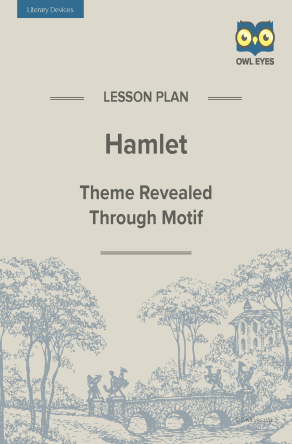Hamlet Literary Devices Lesson Plan
- 23 pages
- Subject: Character Analysis, Literary Devices, Motif, Themes, Lesson Plans and Educational Resources
- Common Core Standards: RL.11-12.1, RL.11-12.2, RL.11-12.3, RL.11-12.5
- Grade Levels: 10, 11, 12, Undergraduate
Additional Hamlet Resources
Product Description
Theme Revealed Through Motif
This lesson plan focuses on Shakespeare’s use of motif in developing an important theme in Hamlet. Students will examine deception as a major motif in the play and interpret what Shakespeare suggests about adopting deceptive behavior to resolve conflicts. Students will focus on Hamlet and Claudius in analyzing and describing examples of deception and will determine the ultimate consequences of their choosing to deceive others. In studying deception as a motif, students will be better able to identify and describe a major theme in the play.
Skills: close reading, drawing inferences from the text, character analysis, identifying theme
Learning objectives: By the end of this lesson, students will be able to
- describe the characters of Hamlet and Claudius and explain their relationship.
- analyze examples of Hamlet’s and Claudius’s acts of deception and determine their motivations in deceiving others.
- explain the consequences of Hamlet’s and Claudius’s choosing to be deceptive.
- identify a major theme in the play and describe how it is developed through the deception motif.
About This Document
Owl Eyes lesson plans have been developed to meet the demanding needs of today’s educational environment and bridge the gap between online learning and in-class instruction. The main components of each plan include the following:
- An introduction to the text
- A step-by-step guide to lesson procedure
- Previous and following lesson synopses for preparation and extension ideas
- A collection of handouts and worksheets complete with answer keys
Each of these comprehensive, 60-minute plans focus on promoting meaningful interaction, analytical skills, and student-centered activities, drawing from the Common Core Standards for English Language Arts and the expertise of classroom teachers.
Introduction to the Lesson
Hamlet, the tragic hero of the play that bears his name, is arguably Shakespeare’s most complex character.
In tracing Hamlet’s emotional and psychological condition through five acts, the play generates more questions about him than answers, creating such ambiguity in his character that the tormented Danish prince has inspired conflicting literary interpretations for centuries. The primary question unresolved in the play concerns Hamlet’s mental state: is he pretending to be mad, as he contends, to deceive Claudius and his court while preparing to avenge King Hamlet’s murder, or does he cross a line into genuine madness? Regardless of what drives Hamlet’s actions, however, his behavior is rife with pretense and deception.
The psychological torment Hamlet endures is intense, making it impossible to rule out the possibility that he loses his grasp on sanity. Hamlet’s learning that his father, King Hamlet, had been murdered by the vile Claudius, who then usurped the throne, forces the young prince to resolve a conflict that defies a solution consistent with his personal feelings, religious beliefs, and the expectations of his society. Hamlet is honor-bound as a loyal, loving son and legitimate heir to the throne to avenge King Hamlet’s murder and punish Claudius’s regicide, the most heinous of crimes; to satisfy what he expects of himself and what the mores of his society demand of him, he must kill Claudius. Decisive action, however, eludes Hamlet, who fears that his killing Claudius will endanger his own soul, for murder is a mortal sin. Overwhelmed by grief and rage and paralyzed by introspection and indecision, he is trapped, unable to free himself from his misery even by committing suicide, because “self-slaughter” is also a mortal sin.
Unable to act decisively in resolving his dilemma, Hamlet pursues one clever scheme after another, deluding himself into believing that he is, in fact, taking action while he merely postpones resolving his conflicts. His various schemes are all rooted in deception—creating a false appearance that belies the truth of what he is thinking and feeling and masks his intentions. In this regard, Hamlet acts in a way that is consistent with the behavior of King Claudius. Claudius also resorts to deceit in addressing conflicts, primarily his conflict with Hamlet, whom he considers a threat to keeping the throne he has usurped. Hamlet’s and Claudius’s various acts of deception drive the plot and create an atmosphere at court that is rife with danger and intrigue. As the plot unfolds, the consequences of their deceptions become increasingly evident and culminate in the play’s tragic conclusion.
Worksheet Excerpt: Analyzing Hamlet’s Acts of Deception
Act I, Scene II:
- How does Hamlet generally act toward King Claudius and Queen Gertrude during his conversation with them in this scene?
- How does Hamlet really feel about Claudius and Gertrude (ll. 132-162)?
- Sum it up: How does Hamlet deceive Claudius and Gertrude?
- Considering Hamlet’s circumstances, why might he have chosen to deceive Claudius and Gertrude?
Act I, Scene V (ll. 189-192):
- Hamlet describes how he intends to behave in a way that will deceive others. What does he intend to do? What might he intend to imply about himself?
- Who, do you assume, will he deceive? Who will not be deceived by the way he intends to behave? Why not?
- Why might Hamlet have chosen to deceive others after speaking with his father’s ghost?







